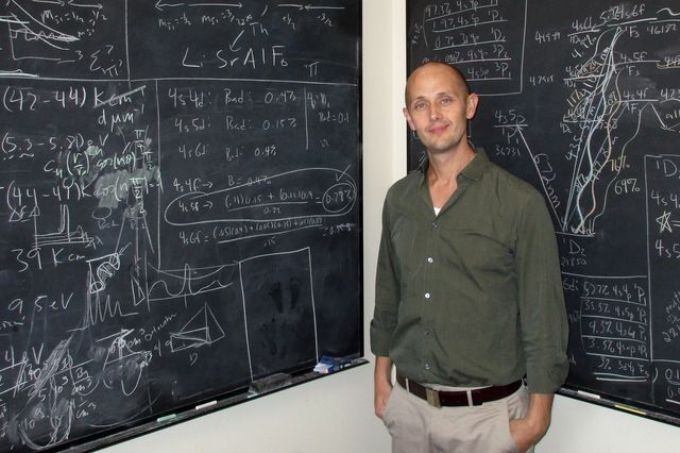Sep 15 2017
Physicists from UCLA have invented a new technique for synthesizing a distinctive new molecule that can, in due course, be used in fields such as food science, medicine, and others. The study also demonstrates the technique for analyzing chemical reactions on a microscopic-scale by applying tools of physics, and has been published in the Science journal.
 By working in extremely controlled conditions, Eric Hudson and his colleagues could observe properties of atoms and molecules that have previously been hidden from view. (Credit: UCLA)
By working in extremely controlled conditions, Eric Hudson and his colleagues could observe properties of atoms and molecules that have previously been hidden from view. (Credit: UCLA)
Over the last two centuries, researchers have created rules for characterizing chemical reactions observed by them, such as reactions occurring in food, living organisms, medications, as well as vitamins. One such universal rule is the “octet rule,” according to which every atom in a molecule produced at the end of a chemical reaction will include eight outer orbiting electrons. Although researchers have discovered certain exceptions to this rule, these exceptions are very rare.
However, the molecule developed by Eric Hudson, a UCLA professor, and his team does not obey this rule. Barium-oxygen-calcium (i.e. BaOCa+) is one of the first molecules discovered by researchers to be formed of an oxygen atom connected to two disparate metal atoms.
In general, one metal atom (calcium or barium) has the ability to react with an oxygen atom to form a stable molecule. Yet, upon adding another metal atom, the UCLA researchers found that a new molecule (i.e. BaOCa+) that does not satisfy the octet rule was formed.
Although other molecules that do not satisfy the octet rule have been discovered earlier, the UCLA research is a pioneer one to zero in on such a molecule by applying tools of physics, such as ion traps, lasers, and ultra-cold atom traps.
Hudson’s laboratory utilized laser light for cooling very small quantities of the reactant molecules and atoms to a very low temperature (i.e. 1/1000 of a degree above absolute zero), and then made them levitate in a space with a width smaller than that of human hair inside a vacuum chamber. By setting such highly controlled conditions, the researchers were able to monitor the characteristics of the molecules and atoms that are not normally visible. The “physics tools” used by the researchers allowed them to use a sample of atoms and monitor the chemical reactions one molecule at an instant.
The ultra-cold temperatures maintained in the study can also be applied to replicate the reaction similar to the way it takes place in outer space. According to Hudson, this can assist researchers to interpret the way in which specific complex molecules (which also include those that may be precursors to life on earth) emerged in space.
The scientists discovered that when barium methoxide and calcium were made to react in their system under normal conditions, they did not react as the atoms did not have a scope to rearrange themselves to generate a stable molecule. Yet when they used a laser to alter the arrangement of the electrons in the calcium atom, the reaction happened swiftly, culminating in a new molecule, namely, CaOBa+.
The technique is part of an innovative physics-based subfield of chemistry that applied the ultra-cold physics tools (e.g. electromagnetism and lasers) to monitor and control the instance and manner in which single-particle reactions take place.
Prateek Puri, a UCLA graduate student and the study’s lead researcher, stated that the research not only shows the way in which these methods can be applied to develop exotic molecules but also how they can be applied to stimulate significant reactions. The discovery can eventually be applied to develop innovative techniques for formulating safer medications by preventing chemical reactions that culminate in negative side effects, and for preserving food by eliminating undesirable chemical reactions between food and its environment.
Experiments like these pave the way for developing new methods for controlling chemistry. We’re essentially creating ‘on buttons’ for reactions.
Puri.
Hudson stated that he considers the study will motivate other researchers to further reduce the gap between chemistry and physics, and to show that highly complex molecules can be analyzed and controlled. He further stated that one way to achieve success in the new research was to involve experts from different fields such as theoretical physicists, experimental physicists, and a physical chemist.
An important part in the study has already made its mark in Hollywood. An apparatus known as the integrated ion-trap-time-of-flight mass spectrometer—invented in Hudson’s lab and used to find out the reaction—appeared on a recent episode of the sitcom “The Big Bang Theory.”
“The device enables us to detect and identify the products of reactions on the single-particle level, and for us, it has really been a bridge between chemistry and physics,” stated Michael Mills, a UCLA graduate student who was part of the study. “We were delighted to see it picked up by the show.”
UCLA research scientist Christian Schneider, University of Connecticut physics postdoctoral scholar Ionel Simbotin, University of Connecticut research professor of physics John Montgomery Jr., University of Connecticut professor of physics Robin Côté, and University of Missouri professor of chemistry Arthur Suits were co-authors of the research.
National Science Foundation and Army Research Office funded the research.